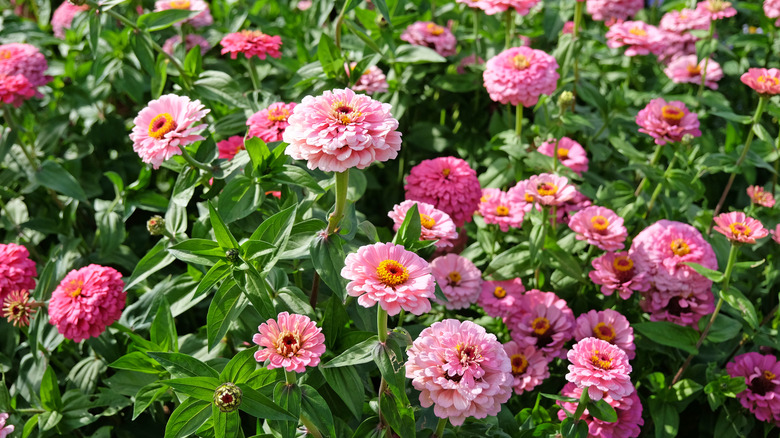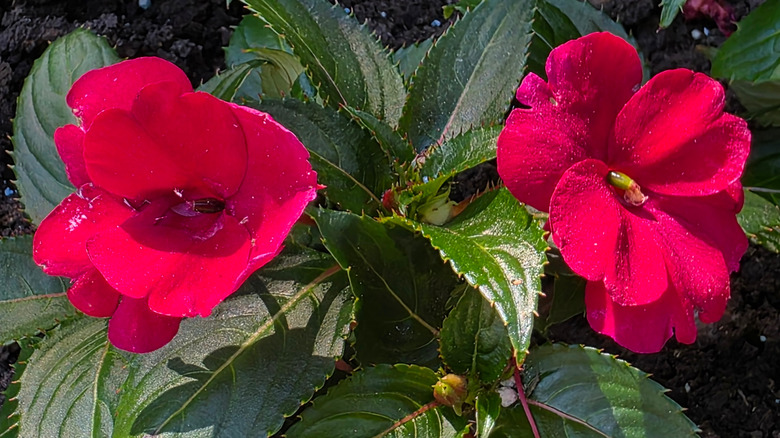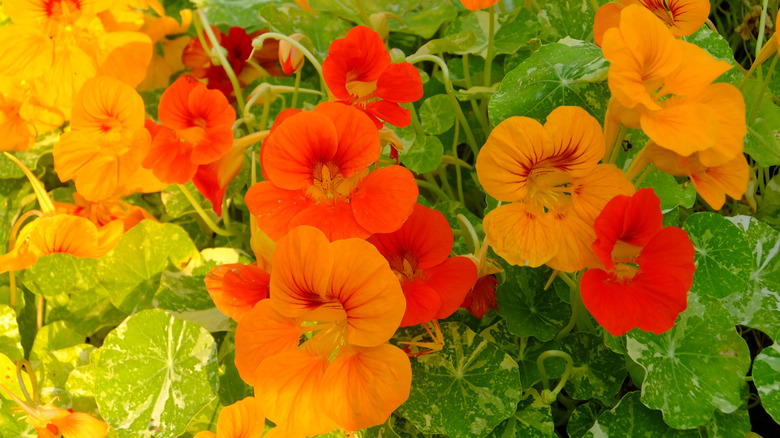The Classic Garden Flower You Should Avoid Planting Near Zinnias At All Costs
It can be incredibly easy to accidentally plant the wrong flowers together in the same flower bed, especially if you love to collect classic garden blooms. But there is one particular flower that shouldn't be anywhere near your zinnias (Zinnia elegans), and that's the common impatiens (Impatiens walleriana). Though both plants are colorful annuals that grow well during warm seasons, they have completely different preferences when it comes to light, water, and soil. This means that impatiens shouldn't be planted with zinnias, even though it might be tempting to do so.
Zinnias love full sun and need well-drained soil to keep their roots happy and blooms strong. However, this sunny and dry environment will scorch the leaves of common impatiens, so planting impatiens next to your zinnias is one of the biggest mistakes to avoid when growing zinnias in your garden. Even though both zinnias and impatiens are colorful garden bed flowers, they can't properly thrive when grown together, and there are better alternatives available if you need a match for your zinnias.
Why zinnias and impatiens don't work together in your garden
Impatiens prefer shady spots with rich, consistently moist soil. They wilt quickly when they need water, which will happen if they're too exposed to the sun or if their soil has dried out. No amount of coaxing will keep them happy for long in a full-sun bed. Zinnias, on the other hand, want six or more hours of full sun per day and perform best in blazing midday light. Their soil preferences also clash. Zinnias like well-drained earth with a pH between 5.5 and 7.5, while impatiens do best in slightly acidic soil between 6.0 and 6.5 with higher moisture content. That means watering or fertilizing one plant might stress or damage the other.
Zinnias are significantly more hardy than impatiens, too. Zinnias can be grown throughout USDA Hardiness zones 2 through 11. They still die when it's cold, but their hardiness makes them suitable for a wide range of climates. In contrast, impatiens are only hardy in zones 10 and 11, making them a poor pairing for zinnias in most gardens. The difference in climate tolerance only makes them more incompatible in the long term.
Try planting nasturtiums or cosmos with your zinnias instead
If you're looking for a plant that will complement your zinnias both visually and practically, nasturtiums (Tropaeolum majus L.) could be a much better choice than impatiens. They share hardiness zones 2 to 11 with zinnias, prefer a similar soil pH of 6 to 8, and enjoy full sun and well-drained soil as much as zinnias do. They also require 10 to 12 inches of space between seeds, matching well with zinnias, which need about 11 to 15 inches of space to maintain the airflow between each plant. A downside to planting too many zinnias in your garden is that overcrowding can result in fewer blooms caused by a lack of airflow, which can result in fungal diseases, but nasturtiums can add some visual interest without overcrowding.
However, there is another alternative flower that fits the soft, cheerful look of impatiens and won't struggle in the sun: Cosmos (Cosmos bipinnatus Cav.). Cosmos flower seeds are quick and easy to grow for beginner gardeners, so those new to gardening will appreciate the ease of zinnias and cosmos together. Though cosmos flowers don't have the same five-petal structure as impatiens, they have a similar delicate appearance that makes them a lovely garden flower. Unlike impatiens, cosmos can actually thrive alongside zinnias in full sun, and are suitable for USDA hardiness zones 2 to 11, which ensures that they'll be excellent companion flowers for both zinnias and nasturtiums if you choose to plant all three alongside each other.


